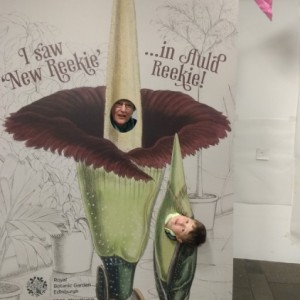New Reekie
Braving the drizzle and expected heavy rain, we went for the fourth time to the Botanics to view the Titan Arum, (Amorphophallus titanum, or New Reekie) this time to take the Flumlet for a once-in-a-lifetime experience. He was well primed as to what it looked like, and what to expect, he behaved well in the car and walking up to the glasshouse so perhaps the actual sighting came as an anticlimax. He did appear somewhat underwhelmed.
However, afterwards when we returned to the ticket hall, where tables were set out for colouring-in and drawing, he was in his element and set to with enthusiasm. Even the promise of seeing the goldfish as we left could not prise him away until he had completed his third, freehand, drawing - that it was of his favourite monster with spikes was irrelevant.
He obligingly joined me in posing in the Titan Arum 'face-in-hole' board, see extra for his unique interpretation.
The population of Amorphophallus titanum in its native Sumatra has declined over the past seventy years, but quite drastically within the past decade or two, due to destruction of rainforest and collecting from the wild, and is now classified as Endangered, hence the importance of increasing the numbers whenever possible. Due to different timing of maturation of the carpel and stamen, the species cannot self-pollinate. When in 2015 the Arum in Edinburgh flowered for the first time there was no source of pollen available; in 2017 pollen was obtained from a botanic garden in the USA but, possibly because it had been frozen, it did not fertilize the flower. This year pollen has been sourced more locally, in the Eden Project in Cornwall and it is hoped that this will succeed in fertilizing the flower and propagate the species. Should this be the case, this individual specimen is unlikely to flower again.

Comments
Sign in or get an account to comment.


